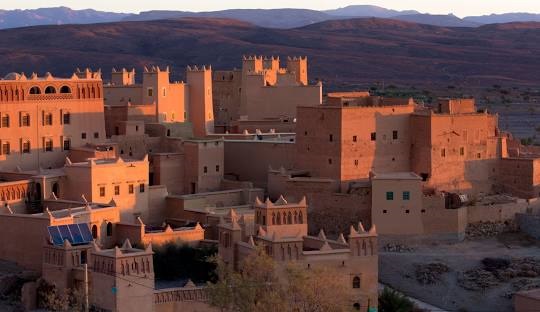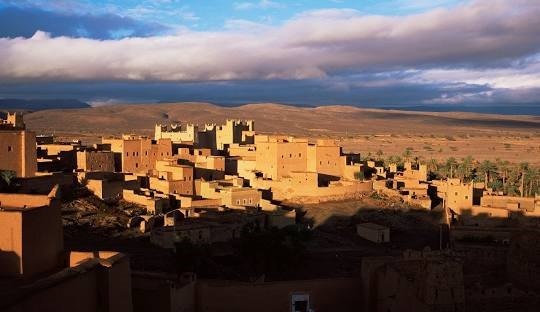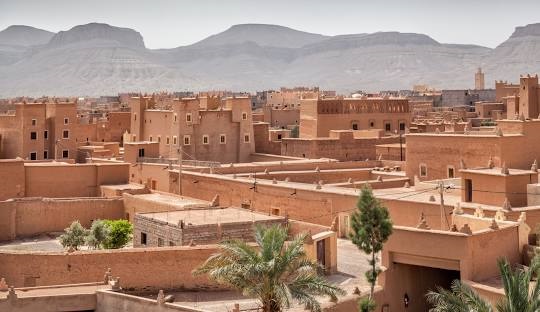The Atlas Mountains, located in northwestern Africa, form one of the most stunning and significant mountain ranges on the African continent. Spanning three countries, from from the Atlantic coast in Morocco to the eastern edge of Tunisia, with Algeria in between, stretching approximately 2,500 kilometers in total.
Mountain Range in Northwestern Africa
The range is divided into several subranges, each with its own unique characteristics, geography, and ecology, making it a region of immense natural, cultural, and historical value. The Atlas Mountains can be broadly categorized into three distinct sections. The High Atlas, home to Riad Nkob, is the most prominent and highest part of the range.
Located primarily in Morocco, this mountain range in northwestern Africa boasts Mount Toubkal, the tallest peak in the north of the continent, rising to an impressive 4,167 meters above sea level. The High Atlas extends from the Atlantic coast near Agadir, running eastward towards the Moroccan-Algerian border. This region is characterized by sharp peaks, deep valleys, and steep, rugged terrain, making it a popular destination for trekkers and adventurers.
In the High Atlas, snow-covered peaks dominate the landscape during the winter months, contrasting sharply with the arid plains below. Traditional Berber villages cling to the hillsides, and the region is known for its unique architecture and terraced agriculture, where crops like barley, wheat, and vegetables are grown despite the harsh conditions.
The High Atlas also serves as a natural barrier, separating the more fertile and developed coastal regions from the vast Sahara desert to the south. To the north of the High Atlas lies the Middle Atlas, a lower and less rugged mountain range in northwestern Africa, extending from central Morocco towards the northeast.
The Middle Atlas, with its highest peak being Jbel Bou Naceur at 3,340 meters, is characterized by rolling hills, wide plateaus, and lush forests of cedar, oak, and pine. This area experiences more rainfall than other parts of the Atlas Mountains, making it an important region for agriculture and forestry. The Middle Atlas is home to several important cities, including Ifrane, often called the Switzerland of Morocco due to its alpine-like appearance and cooler climate.
This mountain range in northwestern Africa also contains several lakes and rivers, which sustain the diverse wildlife, including Barbary macaques and numerous bird species. The Middle Atlas plays a crucial role in Morocco’s water supply, as many rivers, including the Sebou and Oum Er-Rbia, originate exactly here.
South of the High Atlas lies the Anti-Atlas, a much older and geologically distinct range that extends from the Atlantic Ocean in the west to the eastern fringes of Morocco. Unlike the towering peaks of the High Atlas, the Anti-Atlas consists of lower, more eroded mountains, with the highest point being Jbel Sirwa at 3,304 meters.
This mountain range in northwestern Africa is known for its stark, desert-like landscapes, dramatic rock formations, and ancient geological features, in addition to its rich history, as it was home to early Berber civilizations that have left behind impressive archaeological sites, including rock carvings and fortified villages. The Souss Valley, located between the Anti-Atlas and High Atlas, is a fertile agricultural region, famous for its production of argan tree oil.
The Atlas Mountains are the result of a long and complex geological history, shaped by the collision of the African and Eurasian tectonic plates. This activity, which began millions of years ago, pushed up the earth’s crust to form the towering peaks and deep valleys that define the range as we know it exactly as of today.
The formation of this mountain range in northwestern Africa is somewhat analogous to that of the European Alps, as both ranges were created by the same geological forces during the Alpine orogeny. In addition to their tectonic origins, the Atlas Mountains are also notable for their diverse geology. The range is composed of a variety of rock types, including limestone, sandstone, granite, and metamorphic rocks.
In the Anti-Atlas, some of the oldest rocks in Africa can be found, dating back to the Precambrian era, over 500 million years ago. This makes the Atlas Mountains not only a visually striking landscape but also a valuable site for geological research. Due to its extensive length and varying altitudes, the climate of the Atlas Mountains is highly diverse, ranging from Mediterranean in the north to desert-like conditions in the south.
In this mountain range in northwestern Africa, northern slopes, which receive moisture from the Atlantic Ocean and the Mediterranean Sea, are generally wetter and support lush forests of cedar, oak, and juniper. In contrast, the southern slopes, which descend into the Sahara desert, are much drier, with arid steppe and desert vegetation dominating the landscape.
The unique climate zones of the Atlas mountains give rise to a variety of ecosystems and a high level of biodiversity. The region is home to several endemic species, including the endangered Barbary leopard and macaque, in addition to the Cuvier’s gazelle. The forests of the Middle Atlas, particularly those containing the ancient cedar trees, are of great ecological importance and provide critical habitat for wildlife.
In addition to the natural ecosystems, the Atlas Mountains are also an important agricultural mountain range in northwestern Africa. The Berber people, who have inhabited the region for thousands of years, have developed sophisticated methods of farming in the challenging mountain environment. Terrace farming is commonly used to grow crops like wheat, barley, and vegetables, while livestock such as sheep and goats are raised in the higher altitude.
The cultivation of argan trees in the Anti-Atlas is also a vital industry, with the oil extracted from the nuts being highly valued both locally and internationally. The Atlas mountains are not only a natural wonder but also a cultural heartland for the Amazigh people, who have lived in the region for millennia.
Berbers are the indigenous inhabitants of the mountain range in northwestern Africa, with a history that predates the arrival of Arab and Roman influences in the region. They speak a variety of Berber languages, which are part of the Afro-Asiatic language family, and their cultural practices are deeply connected to the mountainous landscape.
Berber villages in the Atlas Mountains are often situated in remote and difficult-to-access areas, where traditional ways of life have been preserved. The architecture of these villages is really distinctive, with houses made of stone or adobe, and flat roofs designed to effectively withstand the extreme weather conditions.
Many communities of the mountain range in northwestern Africa practice subsistence agriculture, although tourism has become an increasingly important part of the local economy in recent decades, particularly in the High Atlas, where trekking and adventure tourism are popular. The Amazigh culture is rich in traditions, including music, dance, and storytelling.
Festivals such as the Imilchil Marriage Festival, which takes place in the mountain range in northwestern Africa, celebrate Berber customs and provide an opportunity for communities to come together. The Berber carpets woven in the Atlas Mountains are highly prized for their intricate patterns and vibrant colors, with each region producing its own distinctive style.
Like many mountainous regions around the world, the Atlas Mountains is a mountain range in northwestern Africa facing a number of environmental challenges, including deforestation, soil erosion, and the effects of climate change. In the Middle Atlas, overgrazing and illegal logging have contributed to the degradation of the cedar forests, while desertification is a growing concern in the southern parts of the range.
In response to these challenges, several conservation initiatives have been launched to protect the unique ecosystems of the mountain range in northwestern Africa. In Morocco, the government and various non-governmental organizations have worked to promote sustainable agricultural practices, reforestation efforts, and the preservation of biodiversity.
The creation of national parks, such as Toubkal National Park in the High Atlas, has also helped to safeguard the mountain range in northwestern Africa and promote eco-friendly tourism. The Atlas Mountains are a region of immense natural beauty and ecological diversity, stretching across the northwestern corner of Africa.
From the snow-capped peaks of the High Atlas to the arid landscapes of the Anti-Atlas, the range offers a striking variety of climates and ecosystems. For centuries, the mountain range in northwestern Africa have been home to the Berber people, whose rich cultural heritage remains intertwined with the land. Despite facing environmental challenges, ongoing conservation efforts offer hope for preserving this unique mountain range for future generations.



